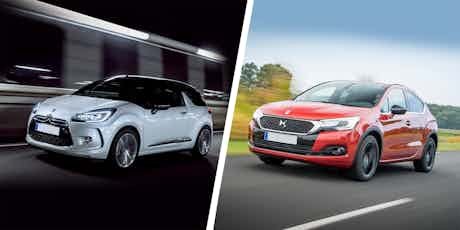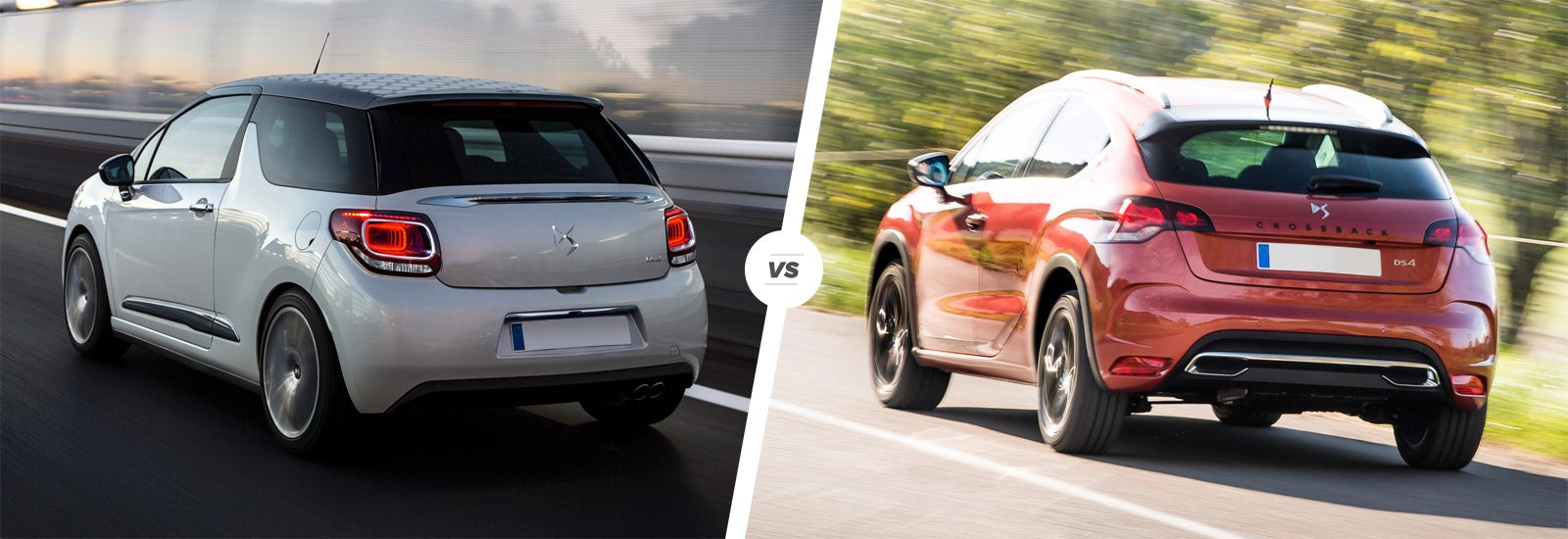Citroen DS3 vs DS4
October 30, 2015 by carwow staff

Citroen has offered buyers a more upmarket ‘DS’ range of cars since 2009. These took their name from the iconic 1950s DS, famous for showcasing technology decades ahead of its time.
In a bid to move further upmarket, the Citroen DS range has now branched off to form a separate brand. Currently, DS models include the DS3 – a stylish supermini competing against the Mini and Fiat 500, the DS4 that can consider the Audi A3 its closest rival and the DS5 which is a quirky take on the compact executive class. We’ve driven both the DS3 and DS4 to find out which appeals the most.
If any cars in the DS range take your fancy, why not use our car configurator to find a great deal on your next new car.
Citroen DS3 vs DS4 styling

It’s hard to mistake the DS3 for anything else in the class thanks to its floating roof design and distinctive ‘shark-fin’ pillar behind the doors. It looks squat and sporty with the rear three-quarter looking especially striking. Overall, it’s well-proportioned and features neat details such as the DS logos embossed within the taillights.
The DS4 has undergone numerous cosmetic changes to make it look more special than the Citroen C4 on which it’s based. A prominent DS grille sits up front, flanked by a set of headlights with LED daytime running lights and – on top spec models – Xenon and LED main beams. Flashes of chrome on the window surrounds add a little class and, like the DS3, similarly shiny trim runs along the base of the doors. The wheel arches are chunky, and the smooth curve of the roofline looks suitably sporty.
It’s offered in two body styles – a premium hatchback and a higher-riding Crossback pseudo-SUV that adds 30mm to the ground clearance, silver roof rails and other SUV styling cues.
Both cars offer plenty of customisation options thanks, in part, to the availability of contrasting roof colours. Both can be chosen with either black, grey-white or purple finishes on top (in addition to the standard body colours) resulting in 32 possible combinations for the DS3 and 38 for the DS4.
Citroen DS3 vs DS4 interior

The DS3 faces some stiff competition within the premium supermini class in terms of cabin design. The Mini’s cabin is a little quirky but very pleasing to sit in and beautifully put together while the Audi A1’s is a little more conventional, yet the build quality is excellent. The DS3 is both fairly nicely built and reasonably interesting to look at but, ultimately, it can’t quite match either. It’s still a comfortable place to sit, through, and a definite step up from the likes of more mainstream rivals such as the Ford Fiesta.
Up front, the DS4 is undoubtedly a wonderful place to be. While the styling isn’t radical compared to Citroens of the past, the build quality is first rate. Those who pick the top spec ‘Prestige’ model can specify a ‘watch strap’ leather interior – which not only features unique quilting on the leather seats, but the dashboard and door cards are trimmed in leather, too.
Unfortunately, things aren’t quite so good for rear seat passengers. A quirk of the unusual rear door opening means rear passenger windows don’t wind down, and overall space is tight. Passenger legroom is made worse by the fact there’s little or no room for feet under the front seats.
Despite being much smaller on the outside, the DS3 offers acceptable interior space within its own class. Like many three-door cars, it can be tricky to get into and out of the rear seats, though.
Citroen DS3 vs DS4 driving

Regardless of spec, the DS3 errs toward the sportier end of the handling spectrum. The suspension responds well with very little hesitation and limits body roll but does have a habit of crashing over anything but the smoothest roads. The gearchange is good if not spectacular and all the controls are light and consistent in their feel. Only the rather numb steering lets the side down, though at least it’s reasonably accurate.
The DS4 suspension has a firm set up aiming to give it a sporty feel, too, but all it achieves is a rather jiggly ride at low speeds without any real sense of involvement. Combine this with the same lacklustre steering as the DS3 and it becomes clear the DS4 is not a driver’s car. The higher-riding Crossback improves things slightly, but not by enough in our view. We can’t help but think it would have been a much better car if Citroen had made ride quality its main priority.
Citroen DS3 vs DS4 engines

Both the DS3 and DS4 are offered with a selection of petrol and diesel engines. The most frugal choice of each range is the 118hp 1.6-litre diesel. In official tests it returns 74.3mpg in the DS4 but, in the lighter DS3, it fares even better – achieving a claimed 78.5mpg. It makes a great choice in both cars because it accelerates smoothly and refinement is above average.
The pick of the DS4 range is the 148hp 2.0-litre diesel which is only marginally less economical. Thanks to significantly more torque, (272lb ft vs 221lb ft) offers much stronger performance. The most powerful diesel, however, is hampered by a dim-witted automatic gearbox, so is best avoided.
Aside from the rather underpowered entry-level 81hp 1.2-litre petrol, it’s hard to go wrong with any of the DS3’s petrol engines, all of which are fairly cheap to run. Even the top spec 163hp 1.6-litre turbo returned almost 50mpg in our hands – very commendable for a car capable of covering the 0-62mph sprint in a brisk 7.5 seconds.
The most powerful engine in the DS4 range isn’t quite so impressive. The 207hp variant of the same 1.6-litre petrol found in the DS3 is a smooth and characterful unit, but one that’s unfortunately spoiled by a six-speed manual gearbox. Sixth gear is far shorter than you might expect, which results in the engine pulling almost 3000rpm at 70mph – effectively ruining its ability to cruise in a refined manner.
Citroen DS3 vs DS4 value for money

The entry level DS3 costs slighlty more than £13,000, though more powerful alternatives to the sluggish 1.2-litre petrol engine cost more. ‘Dsign’ models feature 16-inch alloy wheels, LED daytime running lights and six airbags. If you upgrade to the ‘Dstyle’ trim, you’ll add larger alloys, air conditioning, bluetooth and a seven-inch touchscreen to control the infotainment system. The Dsport and Ultra Prestige trims include, among other features, niceties like leather upholstery and LED/xenon headlights.
The DS4 hatchback is the larger car of the pair so is, predictably, a little more expensive. The ‘Elegance’ trim costs just less than £20,000 and comes with an extensive standard kit list. The SUV-inspired crossback adds about £2,300 to the price, but offers equipment including LED headlights and 18-inch alloy wheels. The top spec Prestige hatchback, meanwhile, features a leather interior, keyless entry and sports seats as standard. The price for the Prestige model is just under £21,000 for the 128hp petrol engine. Aside from the most powerful petrol option, all DS4s are free to tax for the first year.
Citroen DS3 vs DS4 verdict

The DS4 has a number of things going for it – it’s handsome inside and out, very well screwed together, and the smaller petrol and diesel engines look set to be fine choices from a financial point of view. However, there are a few too many negatives to recommend it highly. Its limited cabin space, less than perfect ride quality and numb handling mean it just isn’t quite as good as the DS3.
Unless you really need five doors and a larger boot, the smaller DS3 is a considerably better option. It’s more fun to drive, cheaper to buy and run, and a little more sprightly, too. Of the two, we feel the DS3 comes closest to recreating the offbeat, unique character of the original DS.
Save money on your new DS
If you’ve decided which of these cars is right for you, put a DS3 or DS4 into our car configurator and carwow will find you the best deals from across the UK. If you’re still not sure which car is best for you, our car chooser and deals pages can help.















